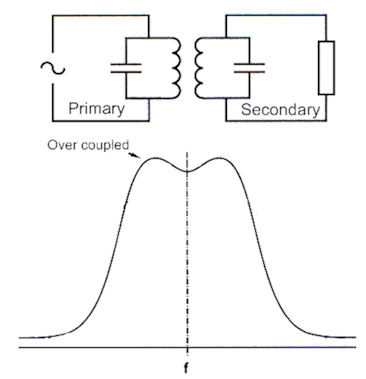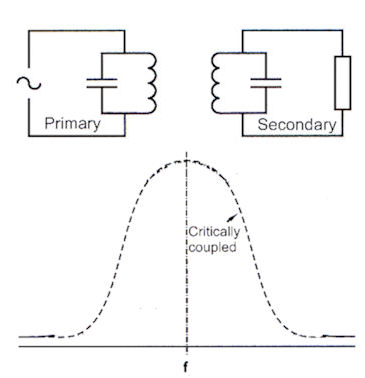

3I4 Understand the operation of an IF amplifier and the IF transformer.
In a standard IF amplifier, whether it is a valve, transistor, or FET, you would have an IF transformer on the input and output. These IF transformers would contain, most of the time, two parallel tuned circuits in the base circuit and two parallel tuned circuits in the collector circuit. There would therefore be 4 stages of selectivity and 4 tuned circuits at IF.
The transformer allows the transfer of RF signal from one stage to the next while isolating the stages electrically (i.e., preventing unwanted signals from passing through).
Understand the concept of two LC tuned circuits utilising transformer coupling.
In the top part of the diagram below you can see two parallel tuned circuits comprising of a coil and capacitor with an AC input signal (remember that a DC signal does work with transformers !!) and a load on the output representing the rest of a circuit. When the two coils are placed relatively close together there is induction between the coils just as in the primary and secondary of a transformer so this is utilising transformer coupling.
IF transformers are usually tuned to a specific intermediate
frequency, meaning they act as bandpass filters. They allow
signals at the intermediate frequency to pass through while
rejecting other frequencies (like RF or LO signals).
In this way, the IF transformer contributes to the selectivity
of the receiver, ensuring that only the desired IF signal is
amplified and processed further.
Identify critical and over-coupled response curves.
When the IF transformers are made the spacing between the two coils of the parallel tuned circuits must be adjusted critically. If the coils are physically too close together we get an over coupling situation which gives what is commonly known as "double humping" where there is a dip in the centre of the response cure as shown in our diagram, which means you have a very wide response.

If you take the coils further apart then you get a wider coupling and this results in a much sharper response curve. Just before the point of over coupling, where the dip becomes noticeable, is the limit to the distance between coils which produces the point of "critical coupling" where the response curve has the steepest sides without the dip in the top.

As you move the coils apart the gain of the stage will reduce as the RF signal has to be coupled between the two. The manufacturer will do their best to provide a good transformer but it might not give you the selectivity you want and you may have to resort to an additional crystal filter.
Understand how the gain of an IF amplifier can be varied, how this may cause distortion and how the effects of the distortion are avoided.
To remind you the AGC is a controlling voltage to increase or reduce the gain of the IF amplifiers hopefully to keep the audio output in the loud speaker constant. Usually the control trigger for this is taken from the detector.
Distortion in the loud speaker or headphones is caused by over driving and this can be avoided by the use of or increase in the AGC control.
3I5 Recall the source and effects of phase noise
Let us first understand a few terms. A "frequency-domain" graph shows how much amplitude of a signal lies within each given frequency band over a range of frequencies.
The frequency-domain is displayed on a spectrum analyser where the X axis (the horizontal one) represents all the scanned frequencies displayed.
In the processing of a wanted signal, Phase Noise is represented in the frequency-domain of a waveform and consists of rapid, short-term, random fluctuations in the phase (or put it another way random fluctuations in the frequency) thus there are changes which detract from the perfect wanted wave form.
Therefore on a Spectrum analyser you would see the changes in the slight frequency also know as the random fluctuation which are short term.
In analogue amateur radio signals one considers phase noise of an oscillator (changes in frequency), whereas in digital-systems the phase noise is with the jitter (slight changes in the speed) of the control clock.
In IF circuits, phase noise can worsen the signal-to-noise ratio (SNR) of the received signal
Recall the unit of measurement is dBc/Hz
Phase noise can be measured using a spectrum analyzer where if the phase noise of the device you are testing is large with respect to the spectrum analysers local oscillator. Care should be taken that observed values are due to the measured signal and not the shape factor of the spectrum analysers filters.
Phase noise is for our amateur radio purposes expressed in units of dBc/Hz, and it represents the noise power relative to the carrier contained in a 1 Hz bandwidth centred at a certain offsets from the carrier.
Where:
dB (decibels) is the ratio of power levels in logarithmic form.
c stands for the carrier signal (the "central" frequency).
Hz refers to the offset in frequency from the carrier where the phase noise is measured.
Example:
If an oscillator has a phase noise measurement of -80 dBc/Hz at 10 kHz offset, this means that the noise power 10 kHz away from the carrier frequency is 80 dB lower than the power of the carrier signal.
To RF Amplifiers and Pre-Amplifiers
To Transmitters and Receivers menu